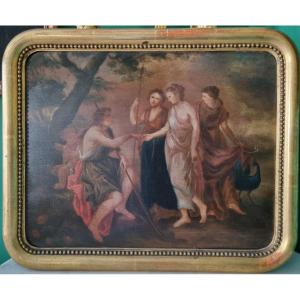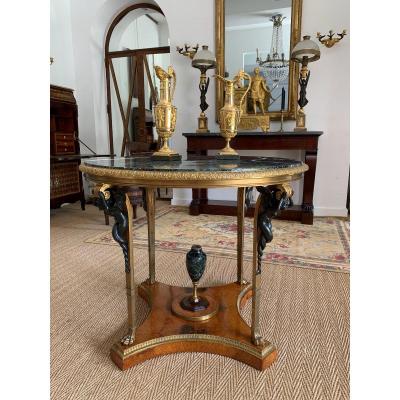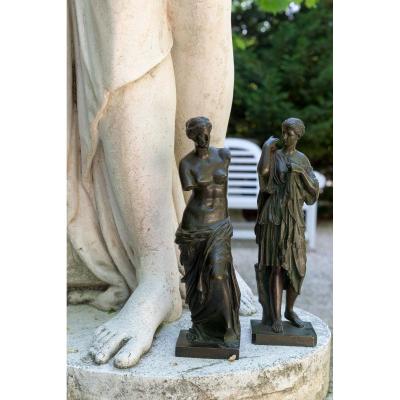In the center, between his two sons, the athletic body, the Laocoon desperately struggles to preserve the lives of his two sons and his own from an unjust and cruel death.
One of the two snakes having risen from the ground, comes to plant his fangs in the body of the already dying youngest, head tilted backwards, while his father struggles to avoid the same fate.
The three protagonists have their limbs tied up in a complex network of powerful reptile knots. You can see the muscles swollen and tense to the extreme of the Laocoon at the limit of his strength. All this under the terrified gaze of the second son, helpless witness to the tragic death of his father.
Good state of conservation, beautiful patina medal (frosted brown).
Small traces, uncleaned bronze.
F.BARBEDIENNE.FONDEUR. signed on the terrace, confirming a cast of the XIXth century (while "Barbedienne fondeur, Paris" indicates a cast from the beginning of the XXth ).
Numbered in ink on the back 3201
Dimensions
Height: 70 cm
Width: 49 cm
Depth: 24.5 cm
A bit of history
Laocoon, priest of the cult of Apollo, had against the will of this latter taken wife and had children.
While the Greeks offer a huge wooden horse to the Trojans for their protector Athena, Laocoon urges them not to let him in. He would have thrown his spear on the sides of the horse.
At the same time, while the latter performed a sacrifice to Neptune on the shore of the Aegean Sea, Apollo (who had not forgotten the insult) sent two monstrous snakes, to the surface of the waves, to kill his two sons. When Laocoon tried to help them, they also killed him by wrapping him in their rings. The two reptiles then took refuge at the feet of the statue of Athena.
The Trojans, unaware of the secret life of their priest Laocoon, made a clumsy interpretation of the wrath of Apollo: the priest had been punished for having degraded the horse offered. The gods actually wanted them to understand that they should let the horse in. And so they did.
The ancient Roman marble group of Laocoon was very inspiring over the last 500 years. It remains probably the most famous of all the ancient sculptures by which generations have been able to have a reflection of their own struggle.
The fascinating exhibition D'après l'antique, presented at the Louvre in 2001, explored the multiple inspirations of the Laocoon. One of the most extraordinary is the engraving by Niccolo Boldrini, made around 1545, less than 50 years after the discovery of the group, which shows the protagonists as monkeys.
Titian’s implication and the real meaning of the print have been, and remain, much debated, but the power of the visual metaphor is intensely striking. Over the centuries, the Laocoon has been used countless times in political parodies and inspired artists from Rubens to Max Ernst. More recently, Jordanian illustrator Emad Hajjaj has brought the relevance of Laocoon to the present day with his striking drawing of Laocoon and his sons struggling with a coronavirus. The image remains a powerful symbol.
As for all my objects and art furniture, I am very attentive to be able to offer them in a very low value of expert estimate.
My objects are taken in natural photography, without passing through artificial lights. Because of this, you can appreciate them as they really are.
Not putting all of my furniture and art objects on my website, I invite you to follow my Instagram account where you can enjoy all the news: @monantiquaire
On request, I manage for you the delivery in France as well as internationally.
Shipping terms depend on your location. Contact me to know the cost and prepare the organization of your delivery.
I make sure that special care is taken to ensure the appropriate packaging and protection for your purchases.
All my Furniture and Art Objects
On my website:
MON ANTIQUAIRE
I look forward to your visit,
Géraldine Buisson.


















































 Le Magazine de PROANTIC
Le Magazine de PROANTIC TRÉSORS Magazine
TRÉSORS Magazine Rivista Artiquariato
Rivista Artiquariato